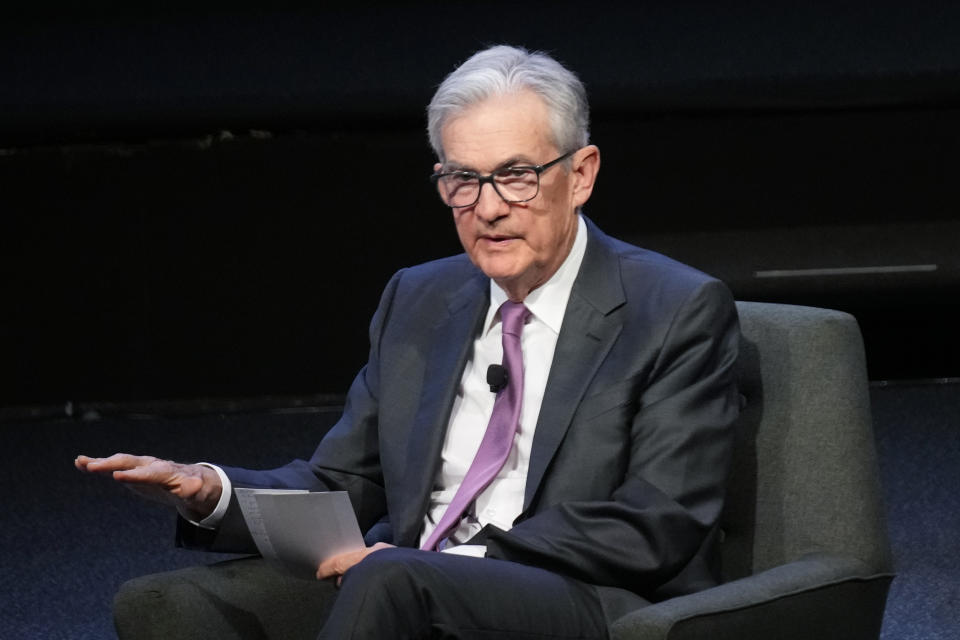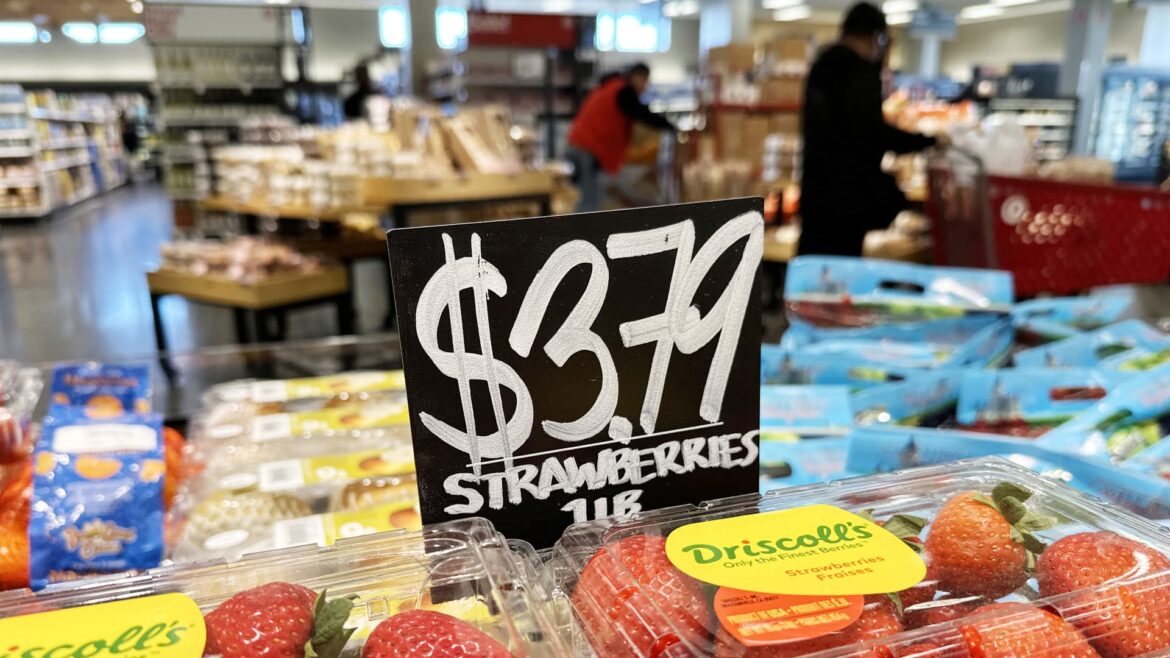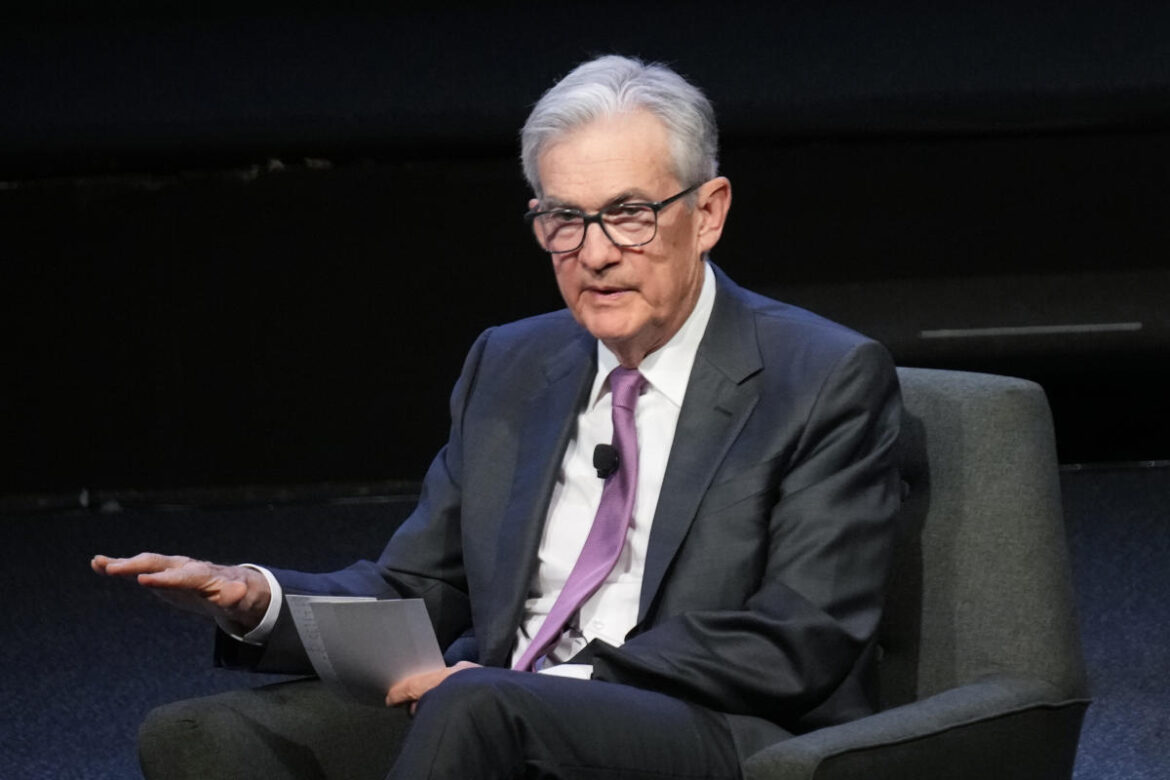 Over the past six months, bitcoin’s value has seen a substantial increase, soaring over 160% in comparison to the U.S. dollar during this period. Despite these significant gains, a considerable number of individuals are of the opinion that this upward trend is just beginning. Yet, the exact start of this crypto bull market is still […]
Over the past six months, bitcoin’s value has seen a substantial increase, soaring over 160% in comparison to the U.S. dollar during this period. Despite these significant gains, a considerable number of individuals are of the opinion that this upward trend is just beginning. Yet, the exact start of this crypto bull market is still […]
Source link
gauge
Inflation as measured by personal spending increased in line with expectations in October, possibly giving the Federal Reserve more incentive to hold rates steady and perhaps start cutting in 2024, according to a data release Thursday.
The personal consumption expenditures price index, excluding food and energy prices, rose 0.2% for the month and 3.5% on a year-over-year basis, the Commerce Department reported. Both numbers aligned with the Dow Jones consensus and were down from respective readings of 0.3% and 3.7% in September.
Headline inflation was flat on the month and at a 3% rate for the 12-month period, the release also showed. Energy prices fell 2.6% on the month, helping keep overall inflation in check, even as food prices increased 0.2%.
Goods prices saw a 0.3% decrease while services rose 0.2%. On the services side, the biggest gainers were international travel, health care and food services and accommodations. In goods, gasoline led the gainers.
Personal income and spending both rose 0.2% on the month, also meeting estimates and indicating that consumers are keeping pace with inflation. However, both numbers fell on the month; income rose 0.4% in September while spending was up 0.7%. Slower spending growth, though, aligns with the Fed’s goal of cooling the economy so inflation can recede.
Stocks rallied following the news, as the Dow Jones Industrial Average hit a 2023 high. Bonds sold off, with Treasury yields popping as the rate-sensitive 2-year note moved up more than 6 basis points (0.06 percentage point) to 4.71%.
Futures market pricing continued to point to the likelihood that the Fed won’t raise rates at any of its upcoming meetings and in fact likely will start cutting by the springtime. In all, traders are pricing in as many as
While the public more closely watches the Labor Department’s consumer price index as an inflation measure, the Fed prefers the core PCE reading. The former measure primarily looks at what goods and services cost, while the latter focuses on what people actually spend, adjusting for consumer behavior when prices fluctuate. Core CPI was at 4% in October while headline was at 3.2%.
In other economic news Thursday, initial weekly jobless claims rose to 218,000, an increase of 7,000 from the previous period though slightly below the 220,000 estimate. However, continuing claims, which run a week behind, surged to 1.93 million, an increase of 86,000 and the highest level since Nov. 27, 2021, the Labor Department said.
“The Fed is on hold for now but their pivot to rate cuts is getting closer,” said Bill Adams, chief economist at Comerica Bank. “Inflation is clearly slowing, and the job market is softening faster than expected.”
Markets already had been pricing in the likelihood that the Fed is done raising interest rates this cycle, and the PCE reading, along with signs of a loosening labor market, could solidify that stance. Along with the anticipation that the rate hikes are over, markets also are pricing in the equivalent of five quarter percentage point rate cuts in 2024.
New York Fed President John Williams said Thursday that he expects inflation to continue to drift lower, finally hitting the Fed’s 2% target in 2025. However, he said policymakers will need to stay vigilant and keep rates at a “restrictive” level.
“My assessment is that we are at, or near, the peak level of the target range of the federal funds rate,” he said in prepared remarks for a speech in New York. “I expect it will be appropriate to maintain a restrictive stance for quite some me to fully restore balance and to bring inflation back to our 2 percent longer-run goal on a sustained basis.”
The fed funds rate, the central bank’s benchmark level for short-term lending, is targeted in a range between 5.25%-5.5%, its highest in more than 22 years. After implementing 11 hikes since March 2022, the Fed skipped its last two meetings, and most policymakers of late have been indicating that they are content now to watch the impact of the previous increases work their way through the economy.
Other economic signals lately have shown the economy to be in fairly good shape, though several Fed officials recently have said the data doesn’t square with comments they are hearing on the ground.
“I’m hearing consumers slowing down,” Richmond Fed President Thomas Barkin said Wednesday at the CNBC CFO Council Summit. “I’m not hearing [the] consumer falling off the table. I’m hearing normalizing, not recession, but I am hearing consumer slowing down.”
The Fed’s inflation report comes the same day as encouraging news from the euro zone.
Headline inflation there fell to 2.4% on a 12-month basis, though core, which excludes food, energy and tobacco, was still at 3.6%, though down from 4.2% in September. Like the Fed, the European Central Bank targets 2% as a healthy inflation level.
Don’t miss these stories from CNBC PRO:
Fed’s preferred inflation gauge shows further signs of price increases cooling
The Federal Reserve’s preferred inflation metric showed prices over the prior month jumped by the most since May while annual price increases continued to cool in September, sharpening the prospects for the central bank to keep interest rates “higher for longer.”
“Core” Personal Consumption Expenditures (PCE) Index, which excludes the volatile food and energy categories, showed prices rose 0.3% in September and 3.7% from the prior year, data released by the Commerce Department on Thursday showed. The 0.3% increase in core PCE was driven by categories like cars, prescription drugs, and travel.
On a headline basis, which includes all categories, PCE rose 3.4% over last year and 0.4% month-over-month. September’s annual rise in “core” PCE was the smallest since May 2021 and marks the third-straight month prices have increased at a slower annual rate.
Core PCE is the inflation measurement preferred by the Fed, as PCE — unlike the more widely cited Consumer Price Index (CPI) — feeds directly into GDP. The Fed targets 2% annual inflation.
The core PCE figure “reflects the stickiness of core services inflation, which is still too strong to be consistent with inflation falling back to the Fed’s 2% target,” Oxford Economics lead economist Michael Pearce wrote in reaction to the data.
In a note to clients on Friday, Ian Shepherdson, chief economist at Pantheon Macroeconomics, said this data is, “not yet good enough for the Fed to declare victory, so next week’s FOMC meeting will bring more of the same message: The fall in inflation is welcome but not yet definitive.”
The Fed is expected to keep rates unchanged in a range of 5.25%-5.50% at the conclusion of its two-day policy meeting on Nov. 1.
Personal spending increased 0.7%, outweighing personal income, which rose 0.3%.
“Disposable income growth has come under pressure as wage and job growth slows,” Pearce said. “The weakness also reflects a slight fiscal tightening as transfer payments decline and as tax payments increase.”
“With incomes falling, higher spending is being funded by lower saving, with the personal saving rate declining to 3.4% in September, its lowest since December 2022,” the economist continued.
“While we estimate there is still a considerable stock of excess saving left over from the pandemic, that is now mostly concentrated among higher income households and appears to be increasingly treated as wealth, so we expect the boost to spending from lower saving to wane from here. We also expect some increase in precautionary saving as the job market slows.”
The price of goods edged up 0.9% in September from a year ago, higher than August’s 0.7% rise. Durable goods fell another 2.3% after falling 1.9% in August while non-durable goods ticked up 2.7%.
Services saw prices rise by 4.7% — below August’s 4.9% increase. Food prices also came in lower compared to the prior month, with September’s reading showing a 2.7% yearly rise compared to a 3.1% jump in August.
Energy goods and services were flat in September after falling 3.6% in August.

Government data released on Thursday showed the US economy grew at its fastest pace in nearly two years during the past three months as consumers stepped up their spending despite a high interest rate environment.
The hot GDP print comes as inflation has remained significantly above the Federal Reserve’s 2% target. A labor market that, while softening in certain areas, is still tight, suggests the Federal Reserve could continue to raise interest rates. The Federal Reserve’s latest meeting minutes showed policymakers support a more restrictive rate environment.
Read more: What the Fed rate-hike pause means for bank accounts, CDs, loans, and credit cards
Cleveland Fed president Loretta Mester said last week she still sees the possibility of one more rate hike this year.
But markets still expect the central bank to keep rates steady at its meeting later this month. Following the release of the data, markets were pricing in a roughly 99% chance that the Federal Reserve keeps rates unchanged at its upcoming policy meeting, according to data from the CME Group.
Alexandra Canal is a Senior Reporter at Yahoo Finance. Follow her on Twitter @allie_canal, LinkedIn, and email her at alexandra.canal@yahoofinance.com.
Click here for the latest economic news and indicators to help inform your investing decisions.
Read the latest financial and business news from Yahoo Finance
What the ‘mysterious shrinking’ of Wall Street’s fear gauge means for stocks, according to DataTrek
Wall Street’s so-called fear gauge has been subdued this year, in a “mysterious shrinking” pattern, that’s a bullish signal for equities, according to DataTrek Research.
Declines for the Cboe Volatility Index
VIX
fear gauge come despite continued worries over inflation and elevated interest rates.
“We’ve been saying for several months that a low VIX is a sign that U.S. stocks are in a bull market rather than being excessively delusional about the obvious challenges ahead,” said Nicholas Colas, co-founder of DataTrek, in a note emailed Monday. “We still believe the next few weeks will be choppy, however.”
The gauge, known by its ticker VIX, has dropped more than 35% so far this year and is trading below its long-term average, according to FactSet data. Its trading levels are derived from options contracts tied to the S&P 500, the U.S. stock benchmark that has rallied 16% in 2023 through Monday.
Last week the VIX made “a new post-pandemic crisis low,” finishing below 13 on Sept. 14 in a “rare occurrence” for the index that was a positive sign for stocks over the next three months, Colas’s note shows. That’s even if it suggests near-term “choppiness” will continue, he said.
On Monday the VIX closed at 14, well below its long-run average of around 20. The measure ended Sept. 14 at 12.8.
“At first glance, this makes little sense,” Colas said. “The VIX is supposed to be Wall Street’s ‘Fear Index’ and it would appear “there’s plenty to be fearful of just now.”
‘Cloudy picture’
Colas cited several areas of concern, including uncertainty surrounding inflation, the recent jump in oil prices
CL00,
and “a cloudy picture” of how long the Fed Reserve will keep interest rates elevated, for his rationale as to why investor might feel fearful.
The Fed has been trying to slow the rise in the cost of living in the U.S. via its restrictive monetary policy, lifting its benchmark rate aggressively over the past 18 months.
There also has been the recent climb in Treasury rates that has weighed on stocks lately, with 10-year Treasury yields looking “set on making new decade-plus highs,” said Colas.
The yield on the 10-year Treasury note
BX:TMUBMUSD10Y
finished Monday at 4.318%, according to Dow Jones Market Data. That’s around levels seen in late 2007, FactSet data show.
‘Seasonal peaks’ in volatility
The VIX had kicked off 2023 trading below its long-run average, with Colas saying in January that it was looking a lot more like 2021, a year in which stocks rallied, rather than 2022, when equities tanked as the Fed rapidly hiked rates.
See: Wall Street’s ‘fear gauge’ VIX shaping up more like 2021 than 2022, as U.S. stocks rally this year, says DataTrek
Meanwhile, September and October are known for “seasonal peaks in equity market volatility,” according to Colas.
U.S. stocks have slumped so far this month, after falling in August. The S&P 500, which dropped 1.8% last month, is down 1.2% in September through Monday, FactSet data show.
The S&P 500
SPX
closed 0.1% higher on Monday while the Nasdaq Composite
COMP
and Dow Jones Industrial Average
DJIA
each finished about flat, as investors digested fresh data showing a drop in confidence among homebuilders this month amid elevated mortgage rates.
Stock-market investors also have been monitoring the U.S. Treasury market’s inverted yield curve, or when shorter-term yields climb above long-term rates, as that historically has preceded a recession.
There’s also some concern over the increased popularity of zero-day options in the stock market, as “you’d think their growing usage would push anticipated volatility higher, not lower,” Colas said.
“We doubt options desks have just walked away from trading 30-day options” on S&P 500 futures, he said. “If there is money to be made in a financial asset, someone invariably trades it.”
The Cboe Volatility Index measures 30-day expected volatility of the U.S. stock market.
“What the ultra-low VIX is telling us is that none of these concerns matter enough to offset a fundamentally strong picture for U.S. corporate earnings and the belief that the Federal Reserve is largely done hiking rates,” said Colas. “Equities are dismissing the possibility of a recession over the next 1-2 years, no matter what an inverted yield curve has historically said on that point.”
Philadelphia Fed manufacturing gauge in expansion territory for first time in a year
The numbers: The Philadelphia Federal Reserve said Thursday its gauge of regional business activity rose to 12 in August from negative 13.5 in the prior month. Any reading above zero indicates expanding activity. This is the first positive reading after 11 straight months of contraction.
The rise in the Philly Fed index was higher than expected. Economists polled by the Wall Street Journal forecast a negative 10 reading in August.
The measure on six-month business outlook dropped 25 points in August to 3.9, its lowest level since May.
Key details: The barometer on new orders jumped 31.9 points to 16 in August. The shipments index rose 18.2 points to 5.7.
The prices paid index rose 11 points to 20.8.
The index for future general activity dropped 25 points to 3.9, its lowest reading since May. Capital spending intentions dropped 13.1 points to -4.5, leaving them just above the cycle low of -5.4, reached in April.
Big picture: Economists have been looking for a bottom in manufacturing activity and the data may be tentative signs of one.
Demand has been weak and manufacturers are struggling with higher interest rates.
Regional readings have been volatile. Earlier this week, the Empire State index showed manufacturing weakened sharply in New York State. The New York Fed’s general business conditions index fell 20.1 points to negative 19 in August.
The New York and Philadelphia Fed indices are two of the first regional manufacturing gauges that offer timely reads of the manufacturing sector.
The national ISM factory index contracted in July for the ninth straight month, rising to 46.4% from 46.% in the prior month.
What are they saying? ” We need much more convincing signals before we believe that the outlook for manufacturing is materially improving,” said Ian Shepherdson, chief economist at Pantheon Macroeconomics.
“A sustained improvement in domestic capital spending is needed if manufacturing is to escape its current rut, given the lack of any meaningful external boost from China’s re-opening,” he added,
Market reaction: Stocks
DJIA
SPX
opened higher on Thursday. The yield on the 10-year Treasury note
BX:TMUBMUSD10Y
rose to 4.31%.





